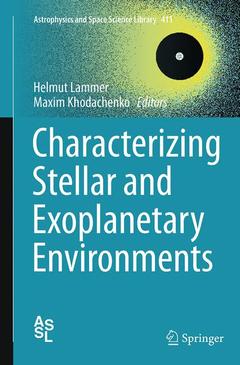Description
Characterizing Stellar and Exoplanetary Environments, 2015
Astrophysics and Space Science Library Series, Vol. 411
Coordinators: Lammer Helmut, Khodachenko Maxim
Language: English
Subjects for Characterizing Stellar and Exoplanetary Environments:
Publication date: 08-2016
Support: Print on demand
Publication date: 11-2014
310 p. · 15.5x23.5 cm · Hardback
Description
/li>Contents
/li>Biography
/li>Comment
/li>
In this book an international group of specialists discusses studies of exoplanets subjected to extreme stellar radiation and plasma conditions. It is shown that such studies will help us to understand how terrestrial planets and their atmospheres, including the early Venus, Earth and Mars, evolved during the host star?s active early phase. The book presents an analysis of findings from Hubble Space Telescope observations of transiting exoplanets, as well as applications of advanced numerical models for characterizing the upper atmosphere structure and stellar environments of exoplanets. The authors also address detections of atoms and molecules in the atmosphere of ?hot Jupiters? by NASA?s Spitzer telescope. The observational and theoretical investigations and discoveries presented are both timely and important in the context of the next generation of space telescopes.
The book is divided into four main parts, grouping chapters on exoplanet host star radiation and plasma environments, exoplanet upper atmosphere and environment observations, exoplanet and stellar magnetospheres, and exoplanet observation and characterization. The book closes with an outlook on the future of this research field.
Exoplanet Host Star Radiation and Plasma Environment.- Stellar Winds in Time.- Magnetic Fields and Winds of Planet Hosting Stars.- Observations of Exoplanet Atmospheres and SurroundingEnvironments.- Types of Hot Jupiter Atmospheres.- Suprathermal Particles in XUV-Heated and Extended ExoplanetaryUpper Atmospheres.- Stellar Driven Evolution of Hydrogen-Dominated Atmospheresfrom Earth-like to Super-Earth-type Exoplanets.- Interpretations of WASP-12b Near-UV Observations.- The Effects of Close-In Exoplanets on Their Host Stars.- Magnetosphere Environment from Solar System Planets/Moons toExoplanets.- Detection Methods and Relevance of Exoplanetary Magnetic Fields.- Alfvén Radius - A Key Parameter for Astrophysical Magnetospheres.- Living with Stars: Future Space-Based Exoplanet Search andCharacterization Missions.- The World Space Observatory–UV Project as a Tool for ExoplanetScience.- Ground-Based Exoplanet Projects.- References.- Index.
He and Maxim Khodachenko are researchers at the Space Research Institute of the Austrian Academy of Sciences.
Presents studies of exoplanets under extreme stellar radiation and plasma conditions
Analyzes findings from Hubble Space Telescope observations of transiting exoplanets
Presents applications of advanced numerical models for characterizing upper atmosphere structure and stellar environments of exoplanets
Addresses detections of atoms and molecules in the atmosphere of "hot Jupiters" by NASA's Spitzer telescope
Edited and written by an international team of experts
Includes supplementary material: sn.pub/extras




